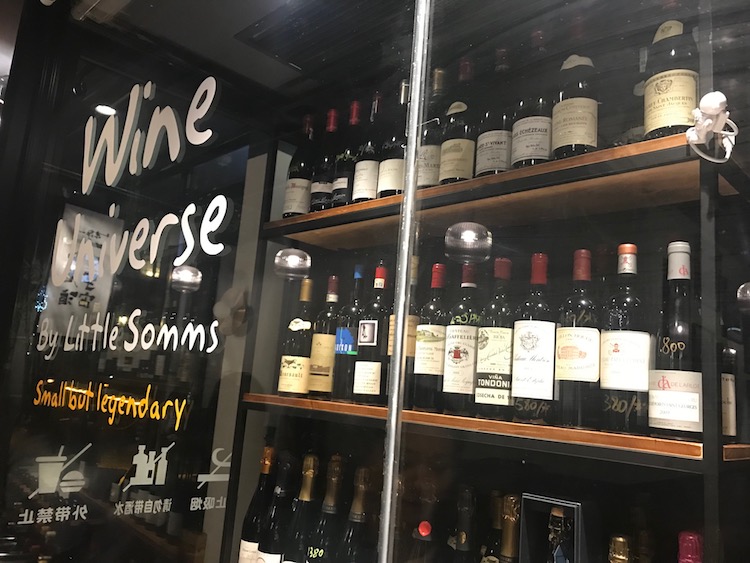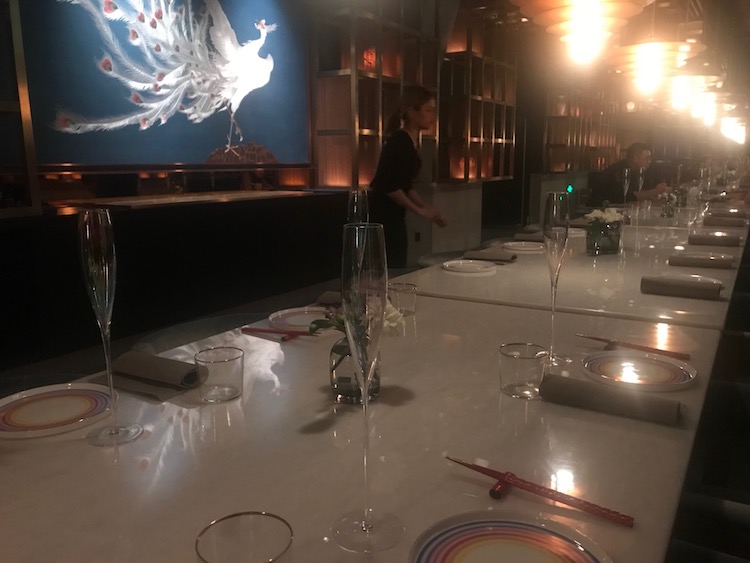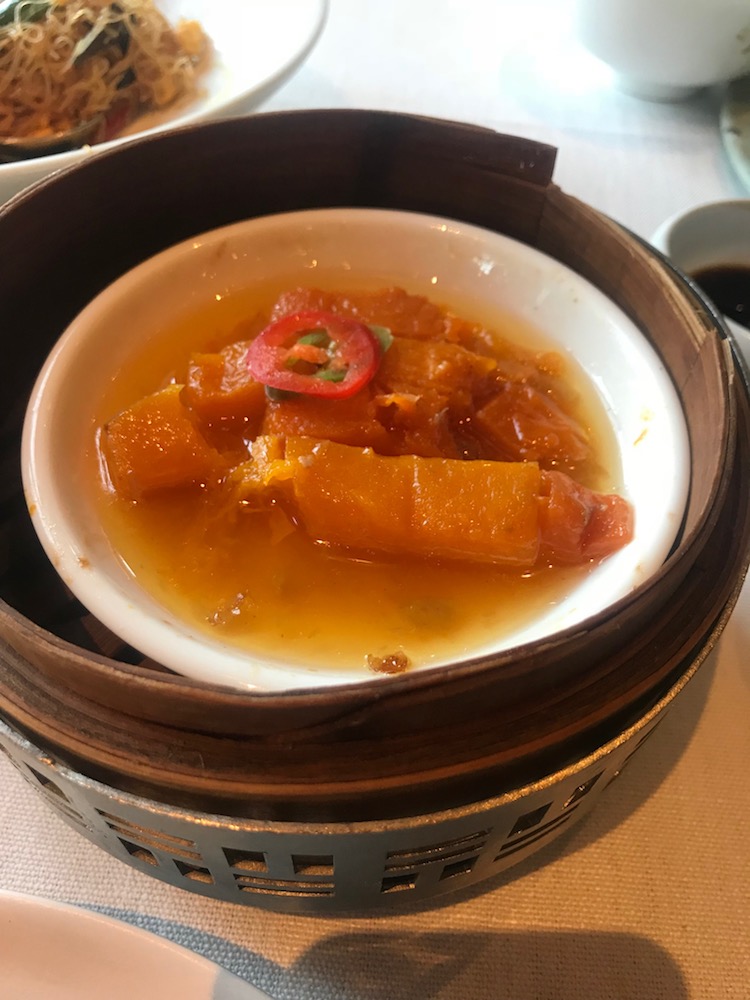Shanghai for wine lovers

A top wine bar by any measure, an ultra-modern restaurant with a keen sommelier, and a place that offers refined Cantonese cooking and a great view. See also Eating good and early in Shanghai published a week ago.
Jasper Sun is like so many young Chinese, but even more so. He is extremely passionate about wine and to date has made a very successful professional life in and around it, initially working for the Shangri La hotel group before tackling the rungs of the world’s arduous sommelier competitions.
Then, four months ago, he embarked on an even more arduous career path, opening his own wine bar, Wine Universe, enthusiastically supported by his wife and business partners.
But what struck me as firstly a reflection of Sun’s passion for the grape and then the scope of the passion he demonstrates in his native Shanghai are the wine bar’s opening hours. Wine Universe is open from 17.30 every afternoon, seven days a week, and closes only when the last customer leaves. Which has been as late (or as early) as 10.30 the following morning.
Sun’s timing and choice of location have been perfect. Wine bars started to open in Shanghai two to three years ago but as so often happens these were ahead of their time and eventually closed.
Judging by the numbers pouring in on the Friday evening we ate and drank there, Wine Universe seems to have got its timing absolutely spot on. And the fact that female customers outnumbered male also impressed me and has encouraged Sun.
The location is a two-storey corner site on the Yuyuan Road, with outdoor seating on the first floor of a building next to a massive courtyard that in the summer converts into an artificial ‘beach’ with sand and water. The outdoor space must be lovely in the warmer weather – Shanghai was very cold when we were there – and the upper floor also houses a very compact kitchen (this being China, every square foot of space is put to very effective use).
Once past the entrance, behind which stand a group of extremely eager young sommeliers, all of them kitted out in black Wine Universe T-shirts with the logo ‘By Little Somms, Small but Legendary’, one comes across the first of two shelves of wine cleverly under the 1,000 RMB mark (£115/$150). These are obviously the most popular.

Further on and set into a corner behind glass panelling, is the temperature-controlled, crammed walk-in cellar that contains the wine bar’s more precious bottles. And it was watching Sun retrieving bottles not just for us but also for other tables that I was reminded of the phrase ‘kid in a candy store’.
It is from here that he draws the 100 wines by the glass, all served via the Coravin system, that keeps his customers so obviously happy. We enjoyed a bottle of Coche Dury Bourgogne Blanc 2016; a glass of Silex 2004 made by the late Didier Daguenau; a Roumier Chambolle 2008; and a small but intensely honeyed glass of Egon Müller’s Scharzhofberger 2010 Auslese from a magnum.
We also ate well, with generous plates of charcuterie and cheeses supplemented by a salad of smoked salmon and an excellent plate of sautéed, spiced prawns.
As Jasper joked when I asked him why the restaurant does not have a website, ‘because I cannot cope at the moment with any more customers’. Long may this continue!
Anyone who, like us, is booking a table at the spectacular and unusual Peacock Room restaurant for the first time is in for a series of surprises and a shock. But that should not deter them.
The initial surprise comes from trying to find the lift that will take you up to the restaurant’s third-floor location. Situated between a shopping mall and the Sukothai hotel in its own three-storey building, The Peacock Room was visible in name only from the ground floor but it looked alluring enough for us to persevere.
After wandering peevishly right round the extensive building in which the restaurant is located, eventually we found the relevant lift, discreetly signalled.
Then on exiting the lift comes the shock. The restaurant is to the right but to the left is a ladies hairdressers and the smells of all the chemicals used pervades the shared lobby. Fortunately, they vanish once inside the restaurant.
Once past the reception of this restaurant, our mouths just gawped in admiration at the restaurateur’s courage and the designer’s confidence.

The Peacock Room occupies one vast, long space and the designer’s response to this challenge has been to fill it with what appears to be one vast long table down the centre of the room. On closer inspection, this is actually made up of a series of tables that can broken into twos, fours and sixes, but the illusion is extremely clever. (There is a private dining room off to one side.)
The interior is in keeping with this ultra-modern look. There is a lot of wood, elegant lighting, good acoustics that muffled the loud music that was being played so we could hear each other talk across the table, and the waiting staff, both male and female, are elegantly and smartly attired.
But it is the food and drink that interest me, and here The Peacock Room scores on both fronts.
The wine list has been compiled by Adrian Zhang, the Group Wine Director for Shanghai FCC Food and Beverage Co Ltd, the small restaurant group that runs this particular restaurant. We began with a glass of Larmandier-Bernier Latitude, the well-renowned grower champagne, before heading off to Sicily for a bottle of Planeta 2014 Eruzione 1614 that was on their bin-end list for 440 RMB (about £49/$65).
Both of these wines, assisted by frequent glasses of water, were just about able to put up with the fierce heat of the cooking. The Peacock Room draws its culinary inspiration from Szechuan, which is undoubtedly the region of China that produces the hottest food.
The chilies in the sauce of our first course were a portent of things to come. Described as chilled octopus with caviar, of which China is now the world’s largest producer, the sauce was mouth-numbingly hot. Cooler, by far, were their four variations on dim sum that followed.
Then we moved on to a creamy combination of stir-fried, minced chicken and a little caviar (pictured below) that was less obvious than in the octopus dish; an intriguing combination of beef scalp and spicy radish; a bowl of spicy Dan Dan noodles; and a plate of delicious long beans with chilli. We finished with a particularly welcome and elegant dish that combined green apple and a green apple sorbet. There followed a bill for 1,104 RMB (about £125/$165).
The Peacock Room is an extremely elegant restaurant, obviously aimed at the young, millennial citizens of this burgeoning city. It makes for a very good night out.
There comes a time in any restaurant reviewer’s life when enough is enough. Buffeted by too many strong flavours, your mouth and stomach crave for the sedate, the more normal.
That was how I felt by Sunday lunchtime in Shanghai. The day before I had enjoyed my first experience of Hanghzou cooking at Le Patio & La Familie and then on the Saturday night my taste buds felt that they were exploding under the strength of the Sechuanese cooking we had experienced at The Peacock Room. There, the first course of jellied octopus topped with caviar, of which China is now the world’s largest producer, had not mentioned what to us appeared to be vast amounts of chilli in the sauce.
Lunch was to be at The Canton Table at No 3 The Bund (where the main picture top right was taken). Cantonese cooking is considered by many far more expert than myself to be the epitome of all the many cooking styles of this diverse country. It relies on the purity of the ingredients, each of which is carefully cooked, with the least amount of spice to mask their flavours.
The day itself could not have been more lovely. After a fortnight of constant rain, the sun was out bringing all who live here to stroll The Bund, Shanghai’s famous riverside walk, all of which is clearly visible from this particular restaurant’s large windows.
The Canton Table occupies a prime site on the fifth floor of a building that also houses Jean-George Vongerichten’s restaurant and is next to the long-established M on The Bund. It has great views across the river to Pudong, the city’s reclaimed-from-wasteland business district with what is now an army of skyscrapers.
The decision to open a restaurant specialising in Cantonese cooking, the cooking of the south of China, was obviously a brave one as this remains one of the few in the city. But it has obviously paid off as the restaurant was pretty busy even in the period just after the Chinese New Year that is the quiet period for restaurants in China.
The six-page dim sum menu is extensive but not that unusual. What is unusual here, as opposed to so many restaurants in this hugely populous city, is the space between tables both in the bar section and in the eating area. This may be one reason why the Canton Table is so popular with foreigners living in Shanghai.

Our meal for two constituted pretty much one dish from each section of the menu. First up were some barbecued pork buns that were crisp and filling followed by perhaps the best dish of the lot in my opinion: steamed beef tripe with a satay sauce, pictured above. This would perhaps not be to everyone’s taste but the meat had been slowly cooked so that it was soft and silky and it was served on top of some fruit that made it even more unctuous.
Then, like London buses, came a sequence of dishes almost all at once. A plate of crisp, barbecued pork served traditionally with mustard; an elegant rendition of prawn cheung fung, filled with plump prawns; deep-fried shrimp dumplings; a bowl of Hong Kong noodles; and some fried glutinous rice with cured meat, hoops of glutinous rice that proved quite a challenge for someone like me not quite entirely comfortable with chopsticks.
With our cups of puer tea continually refreshed, I paid a bill of 567 RMB (£65/$85) for two. Cheaper than a flight to Hong Kong!
This put us both in a fine frame of mind to join Patrick Cranley on one of his walking tours of what remains of old Shanghai. Cranley, American by birth, has lived for over 20 years in this rapidly changing city and has an encyclopaedic knowledge of what the city authorities are in danger of losing for ever. See www.historic-shanghai.com.
Wine Universe 769 Yuyuan Road, Changning District, Shanghai; tel +86 21 5298 6130
The Peacock Room 3F 288 Shimen 1st Road, HKR1 Taikoo Hui South Building, Shanghai, tel +86 21 5239 1999
The Canton Table 5F No 3 Zhongshan East 1st Road, Shanghai Three on The Bund, Shanghai 200002; tel +86 21 6321 3737
Become a member to view this article and thousands more!
- 15,401 featured articles
- 274,903 wine reviews
- Maps from The World Atlas of Wine, 8th edition (RRP £50)
- The Oxford Companion to Wine, 5th edition (RRP £50)
- Members’ forum
- 15,401 featured articles
- 274,903 wine reviews
- Maps from The World Atlas of Wine, 8th edition (RRP £50)
- The Oxford Companion to Wine, 5th edition (RRP £50)
- Members’ forum
- Commercial use of our Tasting Notes


